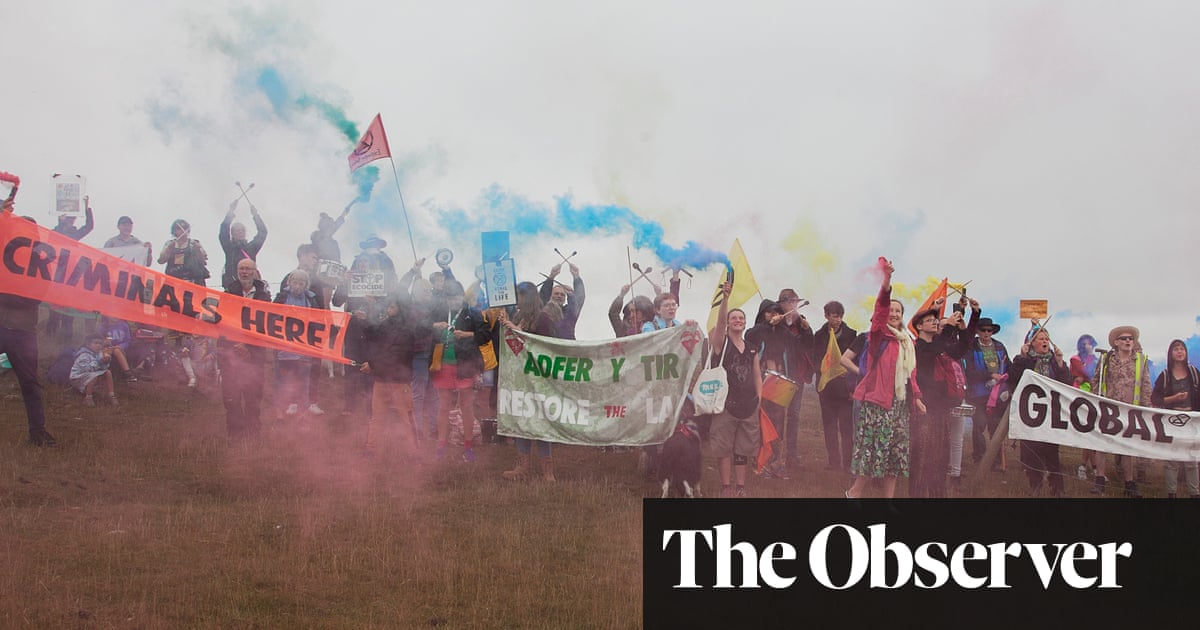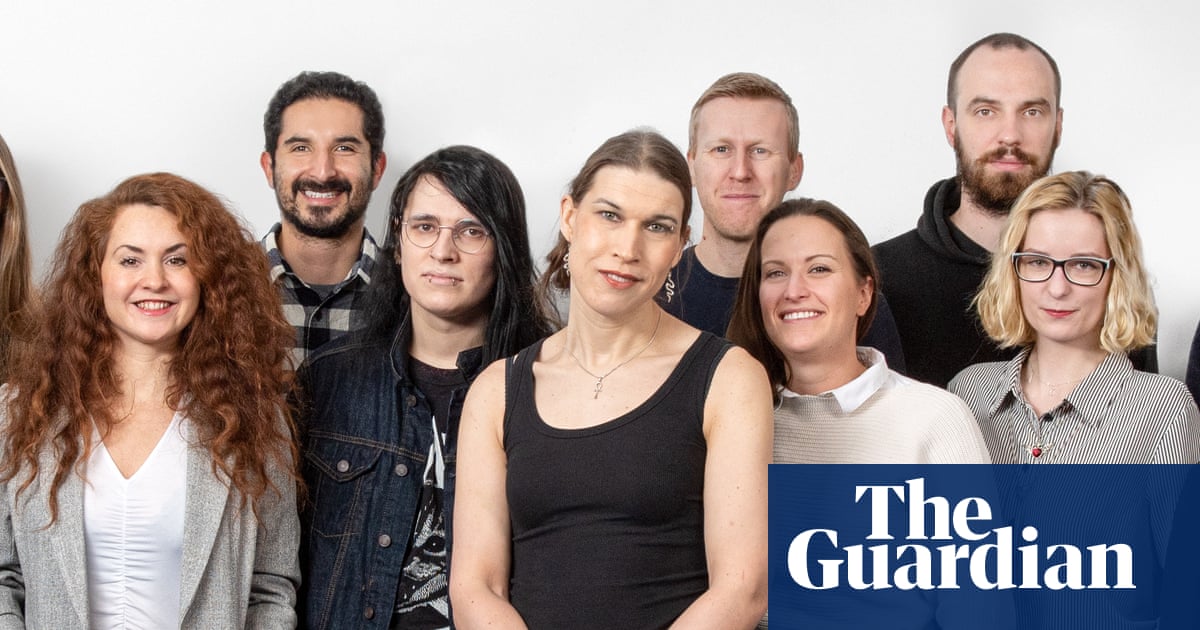
Chris and Alyson Austin have put on a spread. “It’s nothing special, just standard Valleys hospitality,” they each in turn insist, de-clingfilming dishes on their dining table. It’s lunchtime on a rainy summer afternoon in South Wales. Drenched as I am from an hour spent on foot in the countryside surrounding their home on the outskirts of Merthyr Tydfil, the oven chips, sausage rolls and sandwiches (egg mayo, ham) are hugely welcome. “We’ve lived in this house for 20 years. It’s where we’ve raised our kids,” Chris explains. “Both of us grew up in this area.” The couple bought the place when the modern estate was brand new. “I was working in computing in Swansea; Alyson was a bookkeeper. The kids were four and six. It was supposed to be the perfect move. All very traditional.”
“That’s the thing,” Alyson chimes in. “There’s nothing unusual about us at all. We’re Mr and Mrs Normal.” She winks in my direction. Because, of course, the pair are anything but. They might not look like archetypal environmental campaigners, but together they’ve spent the past two decades in the trenches of a colossal climate battle – one that unfolded right on their doorstep. Just a few hundred metres away from where we’re sitting is the Ffos-y-Fran opencast coalmine: the UK’s largest, owned by Merthyr (South Wales) Ltd. Even before it opened, they opposed it. It’s a fight they believe, on all accounts, should long be over. Not only because we know how environmentally damaging burning coal is, amid an ever-escalating climate crisis. It’s also that in September last year, permission to mine there expired. The Austins, expert lawyers and environmental groups all allege it has continued to operate illegally. Coal Authority records reveal that more than 284,000 tonnes of coal have been extracted since September.
Back in 2003, a matter of weeks after moving in, the Austins heard about plans for the coalmine’s imminent opening. A few days later, they attended a meeting at a local church hall, marking a turning point. “We’d always been environmentally conscious,” Chris says, “but we’d never done anything. Suddenly we had to become activists. Not by choice; it was a necessity.”
Opencasts have little in common with the shaft mines one pictures when imagining the South Wales coalfield: those holes dug down into the land, reached by descending lift, with coal extracted and brought to the surface. Rather than starting underground, opencast mining involves digging from ground level. Visible to the eye, anything released in the process immediately enters the environment. As historian Dr Ben Curtis puts it: “This is a different type of mining to that which the industry was built on, starting only in the 1940s. It tends to employ fewer people and is much more visible in the landscape.” Ffos-y-Fran, he adds, has always been controversial. Much larger in scale than most before; dug close to residential areas. “There’s a perception,” he says, “that even if there was coal, that this wouldn’t happen in southeast England. It is hard to imagine.”
Ffos-y-Fran is part of a land-reclamation scheme: a way for the local authority to fund the restoration of landscapes for decades ravaged by heavy industry. Following mining’s decline in the latter part of the 20th century, much of the surrounding countryside became derelict and dangerous. Local government couldn’t afford the vast sums needed to repair the damage. So businesses were permitted to mine areas for one final time. In return, using a proportion of their profits, they’d then restore the land, returning it to the community. “The deal was basically: ‘Take what you want from the land, and then put it all back together,’” Chris explains. “And the first two phases of the East Merthyr Reclamation Scheme were speedy. One included the land our house is built on. But phase three – Ffos-y-Fran – was to last 15 years, and was vast in scale. It seemed far too long for anyone to put up with a coalmine in their back garden. We had to try to stop it.”
It didn’t take long for the Austins to become deeply involved in the campaign. “There was the noise and the disruption, of course,” says Alyson. “We knew there’d be dust everywhere, but it was the medical questions I found most alarming. Our children were five and seven at the time. My son is asthmatic. I was learning about pollution and particulates, the harm it might do.”
Back then, there was little firm evidence about the health consequences of living close to an opencast. A 2007 report by Welsh health authorities recommended “an independent in-depth examination of the wider effects… upon physical health” be undertaken before any mining at Ffos-y-Fran. None happened. “Nobody in power cared about our community’s health,’’ Alyson argues, “because of who lives near here and where we are.” Some of the surrounding areas are among the most deprived in Wales. In fact, to this day, there’s little accessible UK-based research into the community impacts of opencast mining.
Later, I ask Michael Hendryx, Professor Emeritus at Indiana University School of Public Health, whether public health is impacted negatively. “Ten or 15 years ago,” he replies, “I’d have answered maybe. Today, I’m confident to say yes, definitely there are negative health impacts for these communities.” His research has been done in Appalachia, the United States coalmining capital. “Studies here, near large surface coalmining sites, have shown us public health suffers in these areas. We’ve found again and again, ordinary people in these areas are more likely to have chronic forms of respiratory and cardiovascular disease, cancer and other adverse health outcomes. Not because of poverty or other health choices, like smoking. To me it has come to the point where there’s no other explanation.”
In 2005, however, after a tireless two years, the Austins’ campaign was unsuccessful. It was the noise that got them first. “The sound of the hydraulics and the diggers,” Alyson says, before imitating their bass-heavy whirring. “They operated for 16 hours a day from 7am until 11pm. When the wind direction was towards us, there was no getting away from it.”
“Once the mining started,” Chris continues, “everything was constantly covered in black dust… knowing you’re always breathing that in? Just think what it’s doing to your insides.”
Unable to sell their house – “Who wants to live next to a gigantic coalmine?” – the Austins’ struggle continued. “We started to learn about the environmental impact of coal, of fossil fuels,” says Chris. “Not just affecting us, but the global population.”
For 15 years, they refused to give in. There was an attempted years-long legal action; Alyson put herself on the line, risking the house with costs, to lead a test case that made its way to the European Court of Human Rights in Strasbourg. “I was crapping myself,” she says, “but in the end, that failed. Plus, we had all sorts of other things to fight at the same time. A planned incinerator, which we saw off. The mining company tried to open another opencast the same size as Ffos-y-Fran, which was successfully shut down as well.” But, despite their best efforts, mining at Ffos-y-Fran continued.
But on 6 September 2022, the Austins woke up with the champagne ready. “We might not have stopped the damage done to both our community and planet,” Alyson says, “but at least an end to this 15-year nightmare had arrived.” This was the day the licence to mine Ffos-y-Fran expired. “That first hour was magical,” she says, “Then I had to drive up to work, past the mine. I couldn’t believe my eyes: the lorries were still heading down the hillside filled with coal. I stopped the car and watched, confused. We must have got the date wrong, I thought.” But, no; their maths added up. Despite their best efforts to get the authorities to do something, they claim that, initially, no action was forthcoming.
“Nobody seemed to care,” Chris says, bluntly. In fact, in April this year, Merthyr Council refused an application by the company to extend operations until 2024, and in May issued a notice for the company to halt mining. It took effect in late June. Not that it stopped anything.
After a morning spent exploring the area on foot, we drive the few minutes to the spot they’ve planned to show me. As we pull up on the roadside, there’s a large processing plant ahead. Deep in the hillside the mine is barely visible. Instead, from this spot, I’m told to watch the traffic lights ahead, where the public highway intersects with a private, dirt track.
“Up there,” Chris points, “is the mine itself. The lorries transport the coal down, cross this road, and deliver it to these buildings, where it’s sorted and later loaded with diggers on to a train which transports it.” With the company’s permission to mine now firmly expired, I’m expecting to find a clandestine operation behind high fences. Instead, in broad daylight, I watch truck after truck full to the brim with coal come and go. In the 20 or so minutes we are there, I count at least a dozen.
Chris and Alyson aren’t alone in their outrage. Marcus Bailie, 68, is also a local resident. From the garden of his cottage, he tells me how, days earlier, at the entrance of Ffos-y-Fran, he found himself being arrested with Extinction Rebellion. “A group of us chained ourselves to a trailer blocking the mine,” he says. “We did it to try to stop it operating illegally. We’re on a highway to climate hell, with our foot on the accelerator. Round here, nobody can believe this mining has been allowed to go on. This government is allowing illegal extraction of existing fossil fuel sources, while issuing new licences. It’s right on my doorstep, which feels doubly insulting.”
The Valleys village of Fochriw might only be a five-mile drive from Merthyr Tydfil town, but the view from Phil Duggan’s window couldn’t feel more rural. It’s a place, he tells me, that’s proud of its mining traditions. Duggan should know, being one of them. “These are houses built by the National Coal Board for the workers,” he says, of his terraced 1950s home. “I’ve lived in this house for 30 years, it’s my wife’s childhood home. I grew up in the next valley over.” From the age of 16, Duggan worked in the pits. “After the ’84 strike,” he says, “I became an official shot-firer, checking health and safety. I stopped working in 1993 due to chest-health issues.”
Just out of view from his window, over a ridge, is the Ffos-y-Fran coalmine. “Where’s the health and safety for the boys up on the mine now?” he asks. “The young lads up in their yard may as well be on a coalface. The exhaust fumes. The particulates. And I see all the black dust and soot all over the village. It’s going straight into our lungs. When I talk to teachers now, the number of kids they say who are on inhalers around here? It terrifies me.”
“It wasn’t perfect in our day,” he adds, “but lots of us old boys don’t recognise what’s happening up there as mining. There was camaraderie, jobs, oversight and regulation. The landscape was more preserved. We took a hit to our health, yes, us blokes that mined. But it didn’t harm our children. This isn’t that at all. I hope I’m wrong, but I think we’ll have a legacy of that place for years to come. Long after I’m gone. Where is the Welsh government?”
It’s just one of the questions residents have. When contacted for this story, a Welsh Government spokesperson said: “We are unable to comment at this stage, as to do so may jeopardise any future decision Welsh Ministers may have to make on the matter.”
Back in April, Merthyr councillors were told that the mining company had “insufficient funds” set aside to complete the restoration – the heart of the initial deal. Currently, there’s approximately £15m available. A council officer has forecast that somewhere between £75m and £125m will be needed. With organisations like Friends of the Earth and the Coal Action Network piling on the pressure, and the Good Law Project also threatening legal action against the Welsh authorities, it seems at last there’s hope on the horizon. The Coal Authority has issued Merthyr (South Wales) Ltd a notice, too, with inspectors finding mining has taken place outside the licensed geographical area. The company’s website is offline, my emails unanswered; the phone rings out each time I try to call them.
“Now it’s in a complicated legal maze,” Alyson says, frustrated, “where there’s little oversight or explanation and all sorts of appeals. We fear they’ll drag it out for ages. All the while, the mining has carried on. That coal can’t be returned to the ground, the emissions withdrawn. We’re angry, frustrated and disappointed. Whatever happens now, this is proof that tackling the climate crisis won’t come from above. It’ll be led by ordinary people.”
Merthyr (South Wales) Ltd did not respond to the Observer’s approaches for comment, but has previously told Wales Online that it is in “active discussions [with the council] for a safe cessation of coaling which includes ongoing restoration.”












